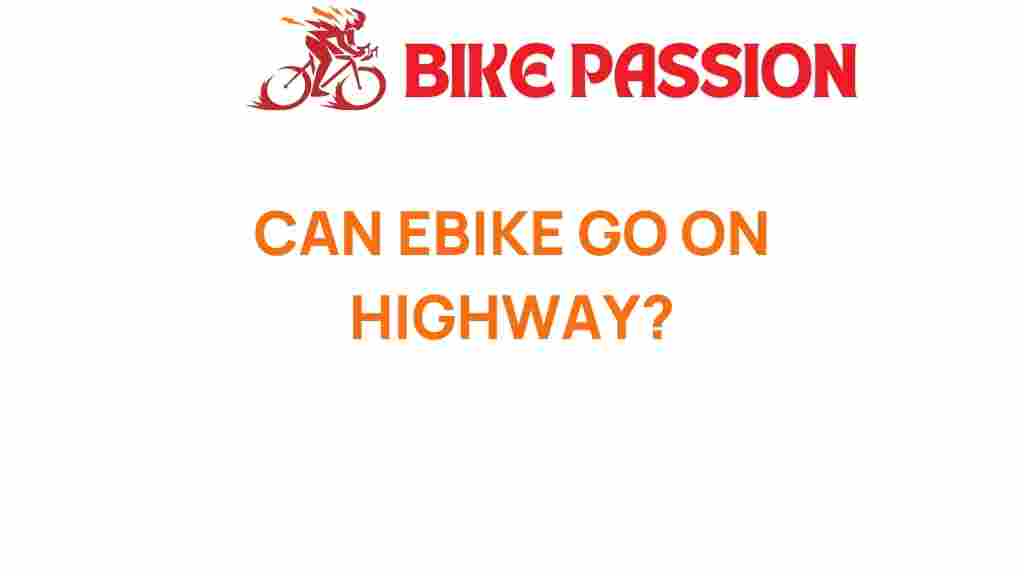Can E-Bikes Tackle Highways? The Surprising Truth Revealed
As urban areas evolve and transportation trends shift, more commuters are turning to e-bikes as a viable option for getting around. With their electric motors, these bicycles offer an alternative to traditional cycling, making them an appealing choice for those looking to navigate the bustling city streets or even tackle the open highways. However, the question remains: can e-bikes safely and legally be used on highways? In this article, we will explore highway regulations, cycling safety, and the overall rider experience when it comes to using electric bikes on major roadways.
The Rise of E-Bikes in Urban Commuting
The last few years have seen a significant surge in the popularity of electric bikes as a mode of transportation. This trend can be attributed to various factors:
- Environmental Awareness: As more individuals seek sustainable transportation options, e-bikes provide an eco-friendly alternative to cars.
- Cost-Effectiveness: E-bikes can save money on fuel and parking, making them an attractive option for urban commuting.
- Health Benefits: Riding an e-bike encourages physical activity while reducing the strain of traditional cycling.
These factors contribute to a growing community of e-bike riders, eager to explore their limits, including the possibility of riding on highways.
Understanding Highway Regulations for E-Bikes
Before considering a ride on the highway, it is essential to understand the highway regulations that apply to e-bikes. Regulations vary significantly by region, so riders must familiarize themselves with local laws. Here are some general points to consider:
- Classification: E-bikes are often classified into different categories, such as Class 1, Class 2, and Class 3, based on their speed and power. Each class may have different permissions regarding road access.
- Bike Lanes vs. Highways: Many regions allow e-bikes in bike lanes, but they may restrict their use on highways. Always check local laws.
- Safety Equipment: Some jurisdictions may require specific safety gear, like helmets and lights, for e-bike riders.
Riders should refer to local transportation departments or government websites to ensure compliance with highway regulations.
Can E-Bikes Legally Access Highways?
The legal access of e-bikes on highways depends heavily on the local regulations. In many places, e-bikes are permitted on highways, but with restrictions. Here are some critical points to consider:
- Speed Limits: Some highways have speed limits that may exclude certain e-bike classes from legal access.
- Traffic Volume: Highways with heavy traffic may not be safe for e-bike riders, regardless of legal permission.
- Infrastructure: The availability of shoulders or dedicated bike lanes can influence whether riding on a highway is advisable.
Always verify local laws to understand whether you can take your e-bike onto the highway legally.
Ensuring Cycling Safety on the Highway
Even if highway access is legally permissible, cycling safety must remain a top priority. Here are some tips for ensuring a safe ride:
- Wear Protective Gear: Always wear a helmet and consider additional protection such as knee and elbow pads.
- Use Lights and Reflectors: Make sure your e-bike is equipped with front and rear lights, as well as reflectors, to increase visibility.
- Stay Alert: Constantly monitor your surroundings and be aware of other vehicles, especially at high speeds.
- Ride Predictably: Use hand signals for turns and lane changes to communicate with drivers effectively.
By prioritizing safety, riders can enjoy their e-bike experience while minimizing risks on the highway.
Preparing for Your Highway Ride
Before hitting the highway with your e-bike, it’s crucial to prepare adequately. Here is a step-by-step process to follow:
- Check Your E-Bike: Ensure your e-bike is in good working condition. Check the brakes, tires, lights, and battery charge.
- Plan Your Route: Choose a route that has bike lanes or less traffic if possible. Use mapping apps that highlight bike-friendly paths.
- Time Your Ride: Consider riding during off-peak hours to avoid heavy traffic on highways.
- Stay Hydrated: Bring water to stay hydrated, especially during long rides.
Following these steps will enhance your overall rider experience and make highway riding safer and more enjoyable.
Troubleshooting Common Issues on the Highway
Even with proper preparation, riders may encounter issues while on the highway. Here are some common problems and troubleshooting tips:
Battery Problems
If your e-bike battery starts to deplete faster than expected:
- Check Battery Health: Ensure the battery is fully charged before your ride.
- Use Eco Mode: If your e-bike has different power modes, use eco mode to conserve battery life.
Tire Issues
Flat tires can occur unexpectedly. To handle this:
- Carry a Repair Kit: Always have a tire repair kit and a pump with you.
- Inspect Tires Regularly: Check for wear and tear before embarking on longer rides.
Traffic Confusion
When navigating busy highways, you may feel overwhelmed. Here are some tips:
- Stay Calm: Maintain composure and don’t panic if you find yourself in a tricky situation.
- Look for Alternatives: If traffic is too heavy, consider taking a side street or finding a safe place to regroup.
Having a plan for these common issues can help maintain a positive riding experience.
Conclusion: The Future of E-Bikes on Highways
The use of e-bikes on highways is a topic that continues to evolve with changes in transportation trends and urban commuting patterns. While many areas allow e-bikes on highways, safety should always be the top priority. Understanding highway regulations, ensuring cycling safety, and preparing for rides are essential for a positive rider experience.
As e-bikes gain popularity, it is likely that regulations will adapt to accommodate this growing mode of transportation. With the right approach, e-bike riders can enjoy the freedom of the open road while contributing to a more sustainable future.
For more information on local regulations and to stay updated on e-bike news, visit the North American Bikeshare Association.
In summary, while e-bikes can tackle highways, it’s crucial to be informed, prepared, and safe. Happy riding!
This article is in the category Routes and created by BikePassion Team
